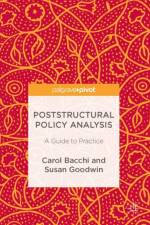- What's the problem represented to be?
av Carol Bacchi
709
This book offers a novel approach to thinking about public policy and a new, distinctive methodology for analysing policy. It introduces a set of six questions that probe how 'problems' are represented in policies, followed by an injunction to apply the questions to one's own policy proposals. This form of analysis, it suggests, is crucial to understanding how policy works, how we are governed, and how the practice of policy-making implicitly constitutes us as subjects. The book mounts a challenge to the problem-solving paradigm currently dominating the intellectual and policy landscape, a paradigm manifest in 'evidence-based policy'. Arguing that such a paradigm denies the shaping that goes on in the process of problematisation, it offers a 'what's the problem represented to be?' approach to policy analysis as a counter-discourse. In this view critical thinking involves putting 'problems' into question rather than learning how to 'solve' them.Bacchi's new approach to policy analysis offers exciting insights in a wide array of policy areas, including welfare, drugs/alcohol and gambling, criminal justice, health, education, immigration and population, media and research policy. Invaluable to those involved in policy studies and public administration, it will also appeal to students and academics in sociology, social work, anthropology, cultural studies and human geography.




